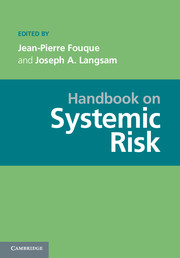Book contents
- Frontmatter
- Contents
- Contributors
- Introduction
- PART I DATA: THE PREREQUISITE FOR MANAGING SYSTEMIC RISK
- PART II STATISTICS AND SYSTEMIC RISK
- PART III MEASURING AND REGULATING SYSTEMIC RISK
- PART IV NETWORKS
- PART V SYSTEMIC RISK ANDMATHEMATICAL FINANCE
- PART VI COUNTERPARTY RISK AND SYSTEMIC RISK
- PART VII ALGORITHMIC TRADING
- 21 Market Microstructure Knowledge Needed for Controlling an Intra-Day Trading Process
- 22 Dynamical Models of Market Impact and Algorithms for Order Execution
- PART VIII BEHAVIORAL FINANCE: THE PSYCHOLOGICAL DIMENSION OF SYSTEMIC RISK
- PART IX REGULATION
- PART X COMPUTATIONAL ISSUES AND REQUIREMENTS
- PART XI ACCOUNTING ISSUES
- References
22 - Dynamical Models of Market Impact and Algorithms for Order Execution
from PART VII - ALGORITHMIC TRADING
Published online by Cambridge University Press: 05 June 2013
- Frontmatter
- Contents
- Contributors
- Introduction
- PART I DATA: THE PREREQUISITE FOR MANAGING SYSTEMIC RISK
- PART II STATISTICS AND SYSTEMIC RISK
- PART III MEASURING AND REGULATING SYSTEMIC RISK
- PART IV NETWORKS
- PART V SYSTEMIC RISK ANDMATHEMATICAL FINANCE
- PART VI COUNTERPARTY RISK AND SYSTEMIC RISK
- PART VII ALGORITHMIC TRADING
- 21 Market Microstructure Knowledge Needed for Controlling an Intra-Day Trading Process
- 22 Dynamical Models of Market Impact and Algorithms for Order Execution
- PART VIII BEHAVIORAL FINANCE: THE PSYCHOLOGICAL DIMENSION OF SYSTEMIC RISK
- PART IX REGULATION
- PART X COMPUTATIONAL ISSUES AND REQUIREMENTS
- PART XI ACCOUNTING ISSUES
- References
Summary
Abstract In this chapter, we review recent work on the regularity of dynamical market impact models and their associated optimal order execution strategies. In particular, we address the question of the stability and existence of optimal strategies, showing that in a large class of models, there is price manipulation and no well-behaved optimal order execution strategy. We also address issues arising from the use of dark pools and predatory trading.
Introduction
Market impact refers to the fact that the execution of a large order influences the price of the underlying asset. Usually, this influence results in an adverse effect creating additional execution costs for the investor who is executing the trade. In some cases, however, generating market impact can also be the primary goal, e.g., when certain central banks buy government bonds in an attempt to lower the corresponding interest rates.
Understanding market impact and optimizing trading strategies to minimize market impact has long been an important goal for large investors. There is typically insufficient liquidity to permit immediate execution of large orders without eating into the limit order book. Thus, to minimize the cost of trading, large trades are split into a sequence of smaller trades, which are then spread out over a certain time interval.
- Type
- Chapter
- Information
- Handbook on Systemic Risk , pp. 579 - 602Publisher: Cambridge University PressPrint publication year: 2013
References
- 79
- Cited by



